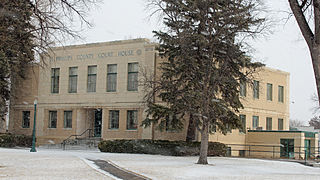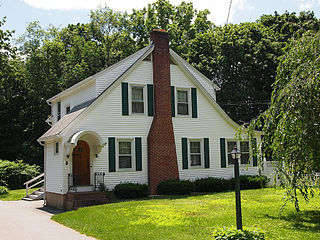
This is a list of the National Register of Historic Places listings in Kandiyohi County, Minnesota. It is intended to be a complete list of the properties and districts on the National Register of Historic Places in Kandiyohi County, Minnesota, United States. The locations of National Register properties and districts for which the latitude and longitude coordinates are included below, may be seen in an online map.

The Greene County Courthouse, located in Jefferson, Iowa, United States, was built in 1918. It was individually listed on the National Register of Historic Places in 1978 as a part of the County Courthouses in Iowa Thematic Resource. In 2011 it was included as a contributing property in the Jefferson Square Commercial Historic District. The courthouse is the third structure to house court functions and county administration.

The Boyd–Wilson Farm is a 157-acre (64 ha) historic district in Franklin, Tennessee, United States. The circa 1840 farm includes an I-house.

Boulder Crescent Place Historic District is a historic area in Colorado Springs, Colorado along West Boulder and Cascade Avenue near the intersection of the two streets. It is a National Register of Historic Places listing and is on the Colorado State Register of Historic Properties.

The Bent County Courthouse and Jail, of Bent County, Colorado, at 725 Carson Ave. in Las Animas, was built in 1887. It was listed on the National Register of Historic Places in 1976; the listing included two contributing buildings.

Abraham Anthony Farm is a historic farm and national historic district located near Blackburn, Catawba County, North Carolina. The district encompasses 13 contributing buildings, 1 contributing site, and 2 contributing structures. The main house was built in 1877, and is a two-story, brick, late Greek Revival style farmhouse. Also on the property is a collection of brick, log, frame and concrete outbuildings and a log cabin.

Alexander Moore Farm is a historic farm and national historic district located near Catawba, Catawba County, North Carolina. The district encompasses 5 contributing buildings and 1 contributing site. The main house was built in 1843, and is a two-story, frame, vernacular late Federal style farmhouse. Also on the property are the contributing log wagon shed, smokehouse, frame barn, and log barn.

George Huffman Farm, also known as the Huffman-Herman Farm and Huffman-Punch-Herman Farm, is a historic farm and national historic district located near Conover, Catawba County, North Carolina. The district encompasses 2 contributing buildings and 1 contributing site. The main house was built about 1810, and is a two-story, single pile, frame, vernacular Federal style farmhouse. Also on the property are the contributing storage shed and Huffman Family Cemetery.

Franklin D. Reinhardt and Harren–Hood Farms, also known as the Franklin D. Reinhardt Farm and Alonzo Harren Farm, is a set of two adjoining historic farms and national historic district located near Maiden, Catawba County, North Carolina. The district encompasses 5 contributing buildings and 1 contributing site. The Franklin D. Reinhardt House was built about 1845, and is a two-story, Greek Revival style dwelling nearly identical to the William Pinckney Reinhardt House. Also on the property is a contributing granary. The Harren-Hood House was built about 1908, and is a two-story frame, late Victorian farmhouse. Also on the property is a contributing granary and cattle barn.

Warlick–Huffman Farm, also known as the Solomon Warlick House, is a historic farm and national historic district located near Propst Crossroads, Catawba County, North Carolina. The district encompasses 7 contributing buildings, 1 contributing site and 7 contributing structures. The house was built about 1820, and is a two-story, vernacular Federal style frame farmhouse. Also on the property are the contributing Kitchen, outhouse, woodshed, six chicken coops, corn crib, and tackhouse / granary.

Wilfong–Wilson Farm, also known as the Major Wilson House, is a historic farm and national historic district located near Startown, Catawba County, North Carolina. The district encompasses 2 contributing buildings, 1 contributing site and 2 contributing structures. The house was built about 1830, and is a two-story, Federal style frame farmhouse. Also on the property are the contributing log smokehouse, corn crib, and potato house.

Bandy Farms Historic District, also known as the Theodore L. Bandy Farm and Joseph S. Bandy Farm, is a historic farm and national historic district located near Bandy's Crossroads, Catawba County, North Carolina. The district encompasses 3 contributing buildings. They are two nearly identical two-story brick farmhouses built in 1884 and 1887, and a one-story brick outbuilding.

Four Mounds Estate Historic District is a nationally recognized historic district located in Dubuque, Iowa, United States. It was listed on the National Register of Historic Places in 2002. At the time of its nomination the district consisted of 19 resources, including 11 contributing buildings, two contributing sites, four non-contributing structures, and two non-contributing buildings. The estate is named for the four conical burial mounds that are located on the property. They are one of the historic sites, and they are individually listed on the National Register of Historic Places.

The Evergreen Corner Rural Historic District in Haxtun, Colorado is a 160-acre (0.65 km2) farm property, a historic district that was listed on the National Register of Historic Places in 2013.

The Millage Farm Rural Historic District in Phillips County, Colorado near Haxtun, Colorado, is a 160 acres (0.65 km2) farm which was listed on the National Register of Historic Places in 2013.

The First Johnson County Asylum is a historic building located on the far west side of Iowa City, Iowa, United States. The first facility Johnson County built to care for paupers and the mentally ill was a four-room cabin in 1855. Two wings were added to the original building six years later. All that remains of this structure is this wing that housed the mentally ill. The single-story wood frame structure with a gable roof was used by the county for this purpose until 1886 when a new facility was completed. It was initially thought that it was built in 1859, but later research revealed that it was built in 1861 and that it was moved a short distance to this location in 1888. This building served for many years as a hog building on the Johnson County Poor Farm. It is now part of an education-based farm program called Grow:Johnson County. The building was individually listed on the National Register of Historic Places in 1978. In 2014 it was included as a contributing property in the Johnson County Poor Farm and Asylum Historic District.

The Johnson County Poor Farm and Asylum Historic District is a nationally recognized historic district located in Iowa City, Iowa, United States. It was listed on the National Register of Historic Places in 2014. At the time of its nomination it consisted of 11 resources, which included three contributing buildings, two contributing sites, four contributing structures and two non-contributing buildings. It also includes the First Johnson County Asylum, which was individually listed on the National Register. The remaining buildings and structures are agricultural in nature, and were built from the late 19th-century to the early 20th-century.

The Podhajsky-Jansa Farmstead District is an agricultural historic district located southwest of Ely, Iowa, United States. It was listed on the National Register of Historic Places in 2000. At the time of its nomination it consisted of 12 resources, which included five contributing buildings, four contributing structures, and three non-contributing structures. The historic buildings include two small side gabled houses ; a two-story, frame, American Foursquare house ; a gabled barn that was moved here from another farm ; and a feeder barn. One of two corncribs (1933), a hog house, and a chicken house are the historic structures. Another corncrib and a couple of metal sheds from the mid to late 20th century are the non-contributing structures.

The Hardin County Home Historic District, also known as Hardin County Poor Farm, Hardin County Farm, and the Hardin County Care Facility, is a nationally recognized historic district located northwest of Eldora, Iowa, United States. It was listed on the National Register of Historic Places in 2010. At the time of its nomination the district consisted of six resources, including three contributing buildings, one contributing site, and two non-contributing buildings. Beginning in the mid-19th century county homes were established across the state to take care of less fortunate residents. That care then extended to the end of the 20th century. The Hardin County Home operated at this location from 1877 to 1996. The historic district encompasses the buildings, farm fields, and cemetery associated with the home. The first burial in the cemetery, located on the southwest corner of the property, was in 1877. The graves are marked with simple stone markers. The last burial was in 2008. Farm fields surround the buildings and extend to the north.

The Chaffee County Poor Farm, near Salida, Colorado, was established in 1891. It was listed on the National Register of Historic Places in 1985. The listing included three contributing buildings.



















